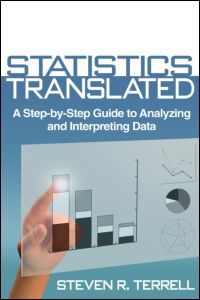Statistics translated A Step-by-Step Guide to Analyzing and Interpreting Data
Langue : Anglais
Auteur : Terrell Steven R.

Written in a humorous and encouraging style, this text shows how the most common statistical tools can be used to answer interesting real-world questions, presented as mysteries to be solved. Engaging research examples lead the reader through a series of six steps, from identifying a researchable problem to stating a hypothesis, identifying independent and dependent variables, and selecting and interpreting appropriate statistical tests. All techniques are demonstrated both manually and with the help of SPSS software. The book provides students and others who may need to read and interpret statistically based research with the essential knowledge and skills needed to make decisions based on data. Useful pedagogical features include: checklists of key words and formulas in every chapter examples of SPSS screenshots used for analyzing data cautionary notes plus "putting it all together" section recaps end-of-chapter self-quizzes (with full answers and explanations) glossary of terms
Introduction: You Do Not Need to be a Statistician to Understand Statistics! A Little Background. Many Students Don--t Know What They--re Getting Into. A Few Simple Steps. Summary. Do You Understand These Key Words and Phrases? Part 1. Identifying a Research Problem and Stating Hypotheses. Step 1: Identify a Problem That Can Be Investigated Using Inferential Statistics. Step 2: State a Hypothesis about the Problem You Are Investigating. Do You Understand These Key Words and Phrases? Quiz Time! Part 2. Identifying the Independent and Dependent Variables in a Hypothesis. Step 3: Be Able to Identify the Independent Variable(s) and the Levels of the Independent Variable(s) in Your Hypothesis. Step 4: Be Able to Identify and Statistically Describe the Dependent Variable(s) in Your Hypothesis. Do You Understand These Key Words and Phrases? Do You Understand These Formulas?Quiz Time! Part 3. Measures of Dispersion and Measures of Relative Standing. Measures of Dispersion. Measures of Relative Standing. Summary of the Measures of Dispersion and Measures of Relative Standing. Do You Understand These Key Words and Phrases? Do You Understand These Formulas? Quiz Time! Part 4. Graphically Describing the Dependent Variable. Graphical Descriptive Statistics. The Normal Distribution. Do You Understand These Key Words and Phrases? Quiz Time! Part 5. Choosing the Right Statistical Test. The Very Basics. How Are We Doing So Far? Estimating Population Parameters Using Confidence Intervals. Predicting a Population Parameter Based on a Sample Statistic Using Confidence Intervals. Testing Hypotheses about a Population Parameter Based on a Sample Statistic. Testing a One-Tailed Hypothesis. Testing a One-Tailed "Less Than" Hypothesis. Summarizing What We Just Said. Be Careful When Changing Your Alpha Values. The Heart of Inferential Statistics. Probability Values. Step 5 Summary of Choosing the Right Statistical Test. Do You Understand These Formulas and Symbols? Quiz Time! Part 6. The One-Sample t-Test. Welcome to the Guinness Breweries. The t Distribution. Let--s Look at a Directional Hypothesis. One More Time. Let--s Use the Six-Step Model. Summary of the One-Sample t-Test. Do You Understand These Key Words and Phrases? Do You Know These Formulas? Quiz Time! Part 7. The Independent-Sample t-Test. If We Have Samples from Two Independent Populations, How Do We Know If They Are Significantly Different from One Another? Putting the Independent-Sample t-Test to Work. Summary of the Independent-Sample t-Test. Do You Understand These Key Words and Phrases? Do You Understand These Formulas? Quiz Time! Part 8. The Dependent-Sample t-Test. That--s Great, But How Do We Test Our Hypothesis? Independence versus Dependence. Testing a Two-Tailed Hypothesis. Let--s Move Forward and Use Our Six-Step Model. The Case of the Unexcused Students. The Case of Never Saying Never. Summary of the Dependent Sample t-Test. Do You Understand These Key Words and Phrases? Do You Understand These Formulas? Quiz Time! Part 9. The Analysis of Variance. Understanding the ANOVA. The Different Types of ANOVAs. Assumptions of the ANOVA. Calculating the ANOVA. The Factorial ANOVA. Interpreting the Interaction p Value. Summary of the ANOVA. Do You Understand These Key Words and Phrases? Do You Understand These Formulas? Quiz Time! Part 10. The Chi-Square Tests. The One-Way Chi-Square Test. The Factorial Chi-Square Test (the Chi-Square Test of Independence). Computing the Chi-Square Statistic. The Chi-Square Test of Independence. Computing Chi-square for the Test of Independence. Post-Hoc Tests Following the Chi-Square. Summary of the Chi-Square Tests. Do You Understand These Key
Students in the behavioral and social sciences; practitioners who are consumers of research, including educational administrators, social workers, clinical psychologists, management professionals, counselors, nurses, and public health workers; early-career academics writing their first journal articles. Serves as a text in upper-division undergraduate and master's-level courses providing an introduction to statistics in practitioner-related fields.
Steven R. Terrell, PhD, is Professor in the Graduate School of Computer and Information Sciences at Nova Southeastern University, where he teaches quantitative and qualitative research methods. He is the author of over 100 journal articles and presentations focusing primarily on student motivation and attrition at all levels of education. Dr. Terrell is active in the American Psychological Association and the American Counseling Association, and recently finished serving as the President of the American Educational Research Association’s Online Teaching and Learning Special Interest Group.
Date de parution : 05-2012
Ouvrage de 402 p.
17.8x25.4 cm
Disponible chez l'éditeur (délai d'approvisionnement : 13 jours).
Prix indicatif 62,49 €
Ajouter au panierThème de Statistics translated :
© 2024 LAVOISIER S.A.S.



